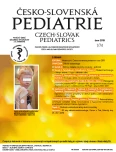Monogenic diabetes MODY in childhood: a retrospective study of patients diagnosed at the Department of Pediatrics, University Hospital in Pilsen in 2000–2017
Authors:
J. Zamboryová 1; R. Pomahačová 1; K. Fiklík 1; L. Elblová 2; J. Sýkora 1
Authors‘ workplace:
Dětská klinika Lékařské fakulty v Plzni, Univerzity Karlovy v Praze a Fakultní nemocnice, Plzeň
1; Pediatrická klinika 2. lékařské fakulty Univerzity Karlovy a Fakultní nemocnice Motol, Praha
2
Published in:
Čes-slov Pediat 2019; 74 (1): 16-21.
Category:
Overview
Objective:
The aim of the retrospective study was to investigate the incidence of monogenic diabetes MODY (Maturity Onset Diabetes of the Young) in patients examined at the Department of Pediatrics, University Hospital in Pilsen in 2000–2017. 16 patients with monogenic diabetes were included in the study: 9 girls and 7 boys with an average age of 10.2 years (ranging from 3 to 17 years).
Methods:
The following parameters were retrospectively analysed in all patients: sex, age at the time of diagnosis, familial incidence of the disease, baseline parameters of carbohydrate metabolism (fasting blood glucose, glycated hemoglobin HbA1c), oral glucose tolerance test (oGTT), intravenous glucose tolerance test (ivGTT), and islet cell autoantibodies. The diagnosis of MODY diabetes was confirmed by molecular genetic testing of GCK, HNF1A, HNF4A a HNF1B genes.
Results:
In the analysed group, 13 cases of GCK-MODY and 3 cases of HNF-diabetes (HNF4A-MODY, HNF1A-MODY, HNF1B-MODY) were confirmed. Patients with GCK-MODY had a slightly elevated fasting blood glucose (6.3–7.3 mmol/l) and HbA1c (median of 46 mmol/mol), impaired glucose tolerance on the oGTT in 94%, physiological first-phase insulin response (FPIR) during ivGTT, and negative islet cell autoantibodies. In one family, the most frequently described mutation in the glucokinase gene p.Glu40Lys in the Czech Republic was confirmed. Patients with HNF-diabetes had a diabetic curve on the oGTT, decreased FPIR during ivGTT, median HbA1c of 64 mmol/mol, and negative islet cell autoantibodies. The diagnosis of GCK-MODY in the families allowed discontinuation of treatment with insulin and oral antidiabetic drugs (OADs) and, in the case of HNF-diabetes, switching from insulin to OADs.
Conclusion:
The differential diagnosis in patients with impaired glucose tolerance or diabetes mellitus should include MODY diabetes. Confirmation or ruling out of the gene mutation predicts disease progression and proper choice of therapy. Knowledge of the gene mutation enables disease detection in the presymptomatic phase in the affected families.
Keywords:
molecular genetic testing – monogenic diabetes – MODY diabetes – oral glucose tolerance test
Sources
- Průhová Š. Monogenní formy diabetes mellitus u dětí a dospívajících. Postgraduální med 2009; 11 (4): 247–252.
- Lebl J, Průhová Š. Monogenní diabetes mellitus: od genetiky k léčbě. Praha: Maxdorf, 2009 : 13–15.
- Průhová Š. Léčba pacientů s monogenním diabetem. Remedia 2011; 21 : 34–39.
- Lebl J, Al Taji E, Koloušková S, a kol. Dětská endokrinologie a diabetologie. Praha: Galén, 2016.
- Průhová Š, Dušátková P, Neumann D, et al. Two cases of diabetic ketoacidosis in HNF1A-MODY linked to severe dehydration: is it time to change the diagnostic criteria for MODY? Diabetes Care 2013 Sep; 36 (9): 2573–2574.
- Heinze E, Holl RW. Tests of β-cell function in childhood and adolescence. In: Ranke MB (ed). Diagnostics of Endocrine Function in Children and Adolescents. Basel: Karger, 2003 : 318–338.
- Matyka KA, Beards F, Appleton M, et al. Genetic testing for maturity onset diabetes of the young in childhood hyperglycaemia. Arch Dis Child 1998; 78 : 552–554.
- Staník J, et al. De novo mutations of GCK, HNF1A and HNF4A may be more frequent in MODY than previously assumed. Diabetologia 2014 Mar; 57 (3): 480–484.
- Ellard S, Bellanné-Chantelot C, Hattersley AT. Best practice guidelines for the molecular genetic diagnosis of maturity-onset diabetes of the young. Diabetologia 2008; 51 : 546–553.
- Ellard S, Beards F, Allen LI, et al. A high prevalence of glucokinase mutations in gestational dia-betic subjects selected by clinical criteria. Diabetologia 2000; 43 : 250–253.
- Pearson ER, Boj SF, Steele AM, et al. Macrosomia and hyperinsulinaemic hypoglycaemia in patients with heterozygous mutations in the HNF4A gene. PLoS Med 2007 Apr; 4 (4): e118.
- Stride A, Ellard S, Clark P, et al. Β-cell dysfunction, insulin sensitivity, and glycosuria precede diabetes in hepatocyte nuclear factor-1 alpha mutation carriers. Diabetes Care 2005, 28 (7): 1751–1756.
- Průhová Š, Dušátková P, Šumník Z, et al. Glucokinase diabetes in 103 families from a country-based study in the Czech Republic: geographically restricted distribution of two prevalent GCK mutations. Pediatr Diabetes 2010; 11 (8): 529–535.
Labels
Neonatology Paediatrics General practitioner for children and adolescentsArticle was published in
Czech-Slovak Pediatrics

2019 Issue 1
Most read in this issue
- Possibilities of antibiotic treatment of acute sinusitis
- The aetiology and treatment of neonatal diabetes
- The role of modern technologies in management of Type 1 diabetes in children
- Risk factors affecting the outcome of newborns undergoing therapeutic hypothermia for hypoxic-ischemic encephalopathy
